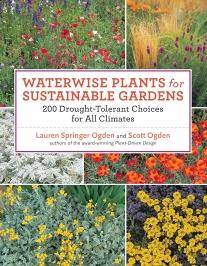Waterwise Plants for Sustainable Gardens by Lauren & Scott Ogden

With the weather changes we all experienced last growing season, gardeners and plant lovers are wondering which way to go. Wait and see? Or assume this year will be better, back to normal or terrific. I'm holding back somewhat. One of the gardening chores that never goes away is watering. What about planting more and more water-wise plants to have the same amount of beauty with a lower water bill and less work? And, if you're living in an area with water restrictions, water wise gardening will make a big difference. Released in Aug, 2011, "Waterwise Plants for Sustainable Gardens", was recommended to me by Russell Studebaker, long-time garden writer for the Tulsa World. The 200 plants covered in the book include trees, shrubs, perennials, ground covers, grasses and sedges, bulbs and their relatives, vines, annuals, biennials, succulents, cacti, palms and fiber plants. Each plant has its own page with photo, growing preferences, attributes and best zones. In ad









